SUMMARY: In Tanzania, patents registration involves submitting an application to the Business Registration and Licensing Agency (BRELA). The agency reviews the application, assessing criteria such as novelty, inventive step, and industrial application. If the invention meets these requirements, a patent certificate is granted. The process includes preliminary and formal examinations, ensuring that only eligible inventions receive protection. If you have an innovative idea, consider exploring patent registration to safeguard your intellectual property in Tanzania. This article guide you achieve just that, lets explore start.
1. Introduction
A patent is one of the various means of intellectual property protection. The World Intellectual Property Organization (WIPO) is the custodian and guardian of patents in the international sphere. The figure below shows an overview of how patenting works internationally.
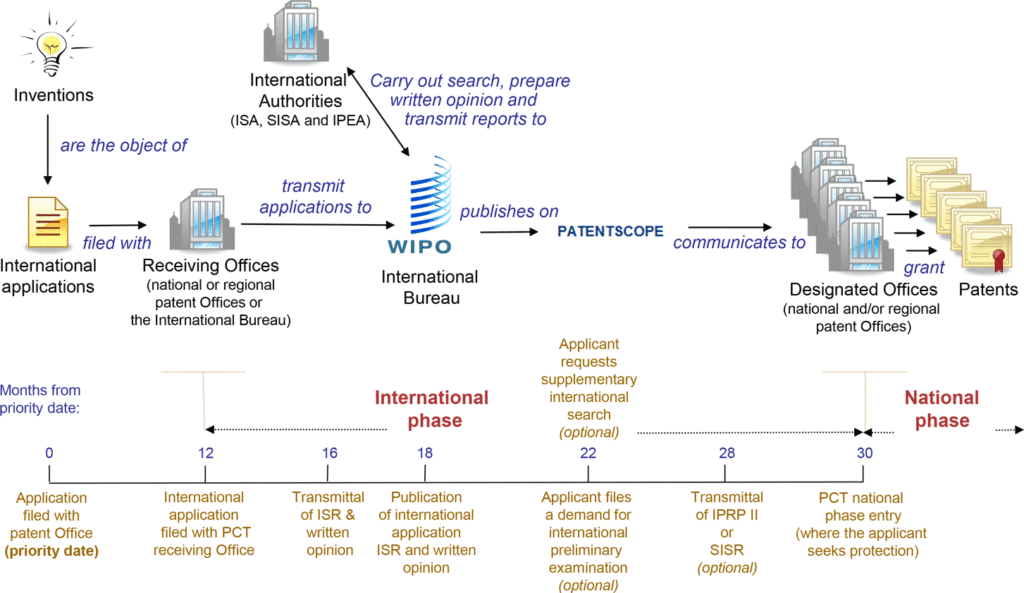
Definition of a patent
A patent is a legal document issued by a government authority that grants the inventor of a new and useful invention the exclusive right to prevent others from making, using, selling, or importing the invention without permission for a limited period, typically 20 years from the filing date of the patent application. It essentially provides the inventor with a monopoly over the invention for a specified period in exchange for disclosing the invention to the public.
Types of Patent
BRELA’s Online Registration System (ORS) provides users with the choice to register either a patent or a utility model. The key distinction lies in the examination process:
- Patent: Requires thorough examination to determine if the invention meets patent criteria, including novelty and non-obviousness.
- Utility Model: Can be granted without extensive examination, as long as it is new and significantly different from existing solutions and inventions
Overview of patents and their importance
Patents are legal protections granted by governments to inventors, providing exclusive rights to make, use, and sell their inventions for a limited period. They serve as incentives for innovation by rewarding inventors with a period of exclusivity, during which they can recoup their investments and profit from their inventions.
In Tanzania, as in many other countries, patents play a crucial role in fostering innovation and economic development. They incentivize individuals and businesses to invest in research and development by providing them with a legal monopoly over their inventions for a specified period, typically 20 years from the filing date of the patent application.
Why patent registration is crucial in Tanzania
Patent registration is particularly crucial in Tanzania due to several reasons:
- Encouraging Innovation: Patent protection encourages inventors to disclose their inventions to the public in exchange for exclusive rights. This disclosure of new technologies contributes to the advancement of knowledge and stimulates further innovation.
- Attracting Investment: A strong patent system attracts both domestic and foreign investment by providing assurance to investors that their intellectual property rights will be protected. This, in turn, leads to increased research and development activities, job creation, and economic growth.
- Promoting Technology Transfer: Patents facilitate technology transfer by providing a legal framework for licensing agreements and collaborations between inventors and other entities. This enables the diffusion of new technologies across different sectors of the economy, thereby promoting productivity and competitiveness.
- Fostering Economic Growth: Patents promote the commercialization of inventions, leading to the creation of new products, processes, and industries. This enhances the overall competitiveness of the Tanzanian economy and contributes to its long-term growth and prosperity.
- Protecting Intellectual Property Rights: Patent registration provides inventors with a legal mechanism to protect their intellectual property rights against unauthorized use, reproduction, or exploitation by others. This helps to deter infringement and unfair competition, thereby safeguarding the interests of innovators and encouraging further innovation.
Types of inventions eligible for patent protection
Inventions eligible for patent protection typically fall into one of the following categories:
- Utility Patents: These are the most common type of patents and cover new and useful processes, machines, articles of manufacture, or compositions of matter. Utility patents protect the functional aspects of an invention, such as how it works or what it does.
- Design Patents: Design patents protect the ornamental or aesthetic aspects of a product’s design. They cover the unique visual appearance of an article, such as its shape, configuration, surface ornamentation, or a combination thereof.
- Plant Patents: Plant patents are granted for new and distinct varieties of plants that have been asexually reproduced, such as by grafting or budding. These patents protect the plant’s genetic characteristics and ensure that the inventor has exclusive rights to propagate, sell, or use the plant variety.
Rights conferred by a patent
Patents confer several rights to the inventor or patent holder, depending on the type of patent granted and the laws of the country where the patent is issued. Here are the primary rights typically associated with a patent:
- Exclusive Rights: The most fundamental right granted by a patent is the exclusive right to prevent others from making, using, selling, or importing the patented invention without the patent holder’s permission. This exclusivity allows the patent holder to control the commercial exploitation of the invention for the duration of the patent term.
- Right to License: The patent holder has the right to license or grant permission to others to use the patented invention in exchange for royalties or other forms of compensation. Licensing agreements enable the patent holder to generate revenue from the invention while allowing others to benefit from its use.
- Right to Enforce: The patent holder has the right to enforce their patent against infringers through legal action. If someone uses, makes, sells, or imports the patented invention without authorization, the patent holder can seek remedies such as injunctions, damages, or royalties through civil litigation.
- Right to Exclude: Patents provide the patent holder with the right to exclude others from exploiting the patented invention, even if the infringing activity occurs unintentionally. This right helps to maintain the integrity of the patent system and incentivize respect for intellectual property rights.
- Right to Transfer: The patent holder has the right to transfer or assign their patent rights to another party, such as through a sale or inheritance. Patent assignments enable inventors to monetize their inventions by transferring ownership of the patent to a third party in exchange for a lump sum payment or other consideration.
Overall, patents confer a bundle of exclusive rights to inventors, providing them with the incentive and legal protection necessary to invest in innovation and bring new technologies to market. These rights play a crucial role in fostering technological progress, economic development, and competition in various industries.
Patentability Requirements in Tanzania
Novelty
Novelty, also known as “newness,” is a fundamental requirement for patentability in Tanzania, as in many other jurisdictions. An invention is considered novel if it is not part of the “prior art,” which includes any information that has been made available to the public before the filing date of the patent application. This includes prior patents, published patent applications, scientific publications, public disclosures, and any other publicly accessible information.
In Tanzania, for an invention to be considered novel and eligible for patent protection, it must not have been disclosed to the public anywhere in the world before the filing date of the patent application. Even a single prior disclosure, whether intentional or unintentional, can destroy the novelty of an invention and render it unpatentable.
Novelty is typically assessed based on the “absolute novelty” standard, which means that the invention must be new compared to the prior art as of the filing date of the patent application. However, some jurisdictions, including Tanzania, provide a grace period during which certain types of disclosures by the inventor or their predecessors are not considered prior art if they occurred within a specified period before the filing date of the patent application.
In summary, novelty is a critical requirement for patentability in Tanzania, ensuring that only truly new inventions are granted patent protection to encourage innovation and prevent the grant of patents for inventions that are already known to the public.
Inventive step
Inventive step, also referred to as “non-obviousness,” is another essential requirement for patentability in Tanzania. It assesses whether an invention involves an inventive leap that would not have been obvious to a person skilled in the relevant technical field at the time the invention was made.
The inventive step requirement aims to ensure that patents are granted only for inventions that represent significant advances over the existing state of the art. An invention may be considered to involve an inventive step if it is not an obvious modification or combination of existing technologies or if it solves a technical problem in a non-obvious manner.
In Tanzania, as in many other jurisdictions, the assessment of inventive step involves evaluating the differences between the claimed invention and the prior art to determine whether the invention would have been obvious to a person skilled in the field. Factors such as the level of skill in the art, the state of the prior art, and any unexpected results or advantages provided by the invention may be taken into account in this analysis.
To satisfy the inventive step requirement, the invention must represent more than mere routine experimentation or the application of known techniques to solve a problem. It should involve a creative or inventive contribution that goes beyond what would have been obvious to a skilled person based on the existing knowledge in the field.
In summary, inventive step is a crucial criterion for patentability in Tanzania, ensuring that patents are granted only for inventions that involve genuine innovation and represent a significant advancement over the prior art. By rewarding inventors for truly inventive contributions, the inventive step requirement promotes technological progress and prevents the grant of patents for trivial or obvious developments.
Industrial applicability
Industrial applicability, also known as “utility” or “usefulness,” is a key requirement for patentability in Tanzania. It refers to the practical utility or usefulness of an invention, i.e., whether the invention can be made or used in some kind of industry.
In Tanzania, as in many other jurisdictions, an invention must possess industrial applicability to be eligible for patent protection. This means that the invention must be capable of being made or used in some kind of industry, including agriculture, manufacturing, technology, or any other field of economic activity.
The requirement of industrial applicability ensures that patents are granted only for inventions that have real-world applications and provide tangible benefits to society. It prevents the grant of patents for purely theoretical or speculative inventions that lack any practical utility or commercial value.
To satisfy the industrial applicability requirement, the patent applicant must demonstrate that the invention is capable of being produced or used in a specific industry or field of technology. This can be achieved by providing experimental data, prototypes, or other evidence to support the practical utility of the invention.
It’s important to note that the industrial applicability requirement does not demand that the invention be commercially successful or economically viable. Instead, it focuses on whether the invention is capable of being made or used in some kind of industry, regardless of its commercial potential.
In summary, industrial applicability is a fundamental requirement for patentability in Tanzania, ensuring that patents are granted only for inventions that have practical utility and can be applied in real-world industries. By requiring inventions to possess industrial applicability, the patent system promotes the development and dissemination of useful technologies that contribute to economic growth and societal progress.
Exclusions from patentability
While patents are granted to protect new and useful inventions, certain subject matters are excluded from patentability in Tanzania, as in many other jurisdictions. These exclusions aim to balance the interests of inventors with the broader public interest in promoting innovation, competition, and access to knowledge. Some common exclusions from patentability include:
Discoveries and Scientific Theories
Pure discoveries of existing natural laws, phenomena, or scientific principles, as well as abstract scientific theories, are generally not eligible for patent protection. This exclusion ensures that basic scientific knowledge remains freely accessible to the public and is not monopolized by individual inventors.
Mathematical Methods and Algorithms
Pure mathematical methods, algorithms, and computer programs as such are typically excluded from patentability. While inventions that involve technical applications of mathematical principles may still be patentable, patents cannot be granted for mathematical concepts or methods themselves.
Schemes, Rules, and Methods for Performing Mental Acts
Business methods, schemes, rules, and methods for performing mental acts or playing games are often excluded from patentability. These exclusions prevent the grant of patents for purely abstract or non-technical innovations that do not involve a technical solution to a technical problem.
Methods of Treatment and Diagnostic Methods for Humans or Animals
Methods of medical treatment and diagnostic methods practiced on humans or animals are generally excluded from patentability to prevent the monopolization of healthcare practices and ensure access to essential medical treatments and procedures.
Plant or Animal Varieties
Plant or animal varieties that are predominantly the result of biological processes, such as natural selection or cross-breeding, are typically excluded from patentability. However, certain genetically modified organisms or microorganisms may still be eligible for patent protection if they meet the other patentability requirements.
Essentially Biological Processes for the Production of Plants or Animals
Processes for the production of plants or animals that are based on essentially biological processes, such as breeding or selection techniques, are often excluded from patentability to preserve the integrity of traditional agricultural practices and ensure access to plant and animal genetic resources.
It’s important to note that while these subject matters are excluded from patentability, they may still be protected by other forms of intellectual property rights, such as copyright, trade secrets, or plant variety protection.
In summary, exclusions from patentability in Tanzania aim to ensure that patents are granted only for inventions that meet certain criteria of novelty, inventive step, and industrial applicability, while preventing the grant of patents for subject matters that are considered inappropriate for patent protection. These exclusions help to maintain a balance between the interests of inventors and the broader public interest in promoting innovation, competition, and access to knowledge.
2. Patents Registration Steps and Procedures in Tanzania
To register a patent in Tanzania, you need to follow eight steps which are (1) Doing a patent search, (2) Drafting patent documents, (3) Creating BRELA ORS account, (4) Signing in to the BRELA ORS System, (5) Creating the online application, (6) Filling in the online application form, (7) Uploading patent documents and (8) Paying patent fee.
Step 1: Conducting a Patent Search
Before filing a patent application in Tanzania, it’s essential to conduct a prior patent search to assess the novelty and inventiveness of the invention. The Business Registrations and Licensing Agency (BRELA) offers a patent search service, which allows individuals and businesses to search for existing patents and ongoing patent applications. Doing a patent search helps identifying any existing patents that may be similar to an invention that an inventor intends to register, and hence it helps avoiding infringing on another person’s patent.
Step 2: Drafting Patent Documents
The documents required are patent specification, Claim or Claims, Drawings, proof of right to file from inventor, power of attorney when applying through an agent, priority documents for applications under PCT.
- Title and Abstract: Start with a concise and descriptive title that accurately reflects the nature of the invention. Follow it with an abstract summarizing the technical field, problem addressed by the invention, and its key features and advantages.
- Description of the Invention: Provide a detailed description of the invention, including its technical background, objectives, and a clear explanation of how it works. Describe the invention’s components, elements, and any novel features or improvements over existing technologies.
- Drawings (if applicable): Include drawings, diagrams, or figures to illustrate the invention and facilitate understanding. Ensure that the drawings are clear, labeled appropriately, and support the written description of the invention.
- Claims: Draft one or more patent claims that define the scope of protection sought by the patent applicant. Claims should be clear, concise, and supported by the description of the invention. They should define the essential features of the invention and distinguish it from the prior art.
- Specification: Provide a detailed specification that supports the claims and provides sufficient information for someone skilled in the relevant technical field to implement the invention. Include specific examples, experimental data, and any necessary details to enable reproduction of the invention.
Step 3: Create BRELA ORS Account
Open a browser preferably using a computer and navigate to https://ors.brela.go.tz and follow all the steps outlined in the how to create brela ors account.
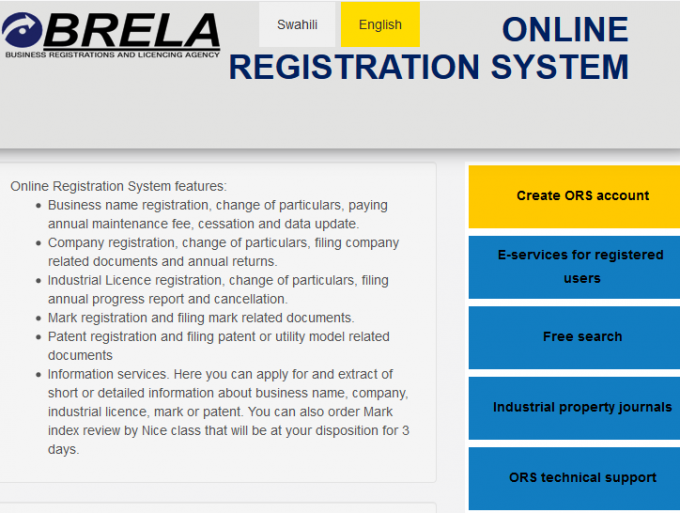
Step 4: Login to BRELA ORS System
Navigate to https://ors.brela.go.tz/ using your browser preferably using a computer not phone and click the E-services for registered user option. You should see the following screen. You should input your username and password and sign in.
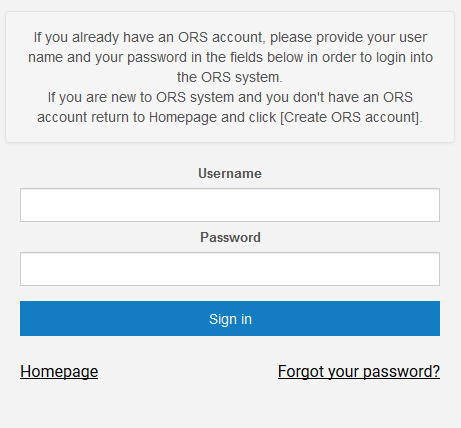
Step 5: Create the application
Create the application by clicking on the New e-service button, then selecting patent and new request for new grant of patent / utility model.
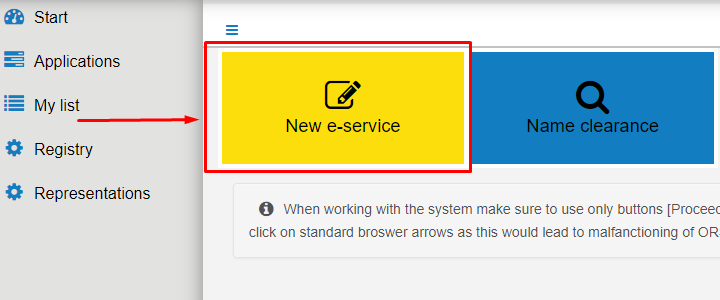
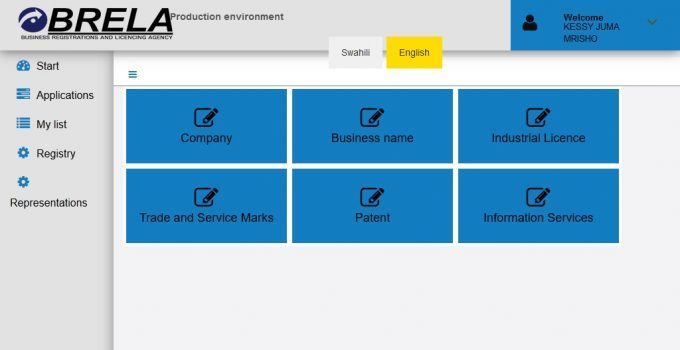
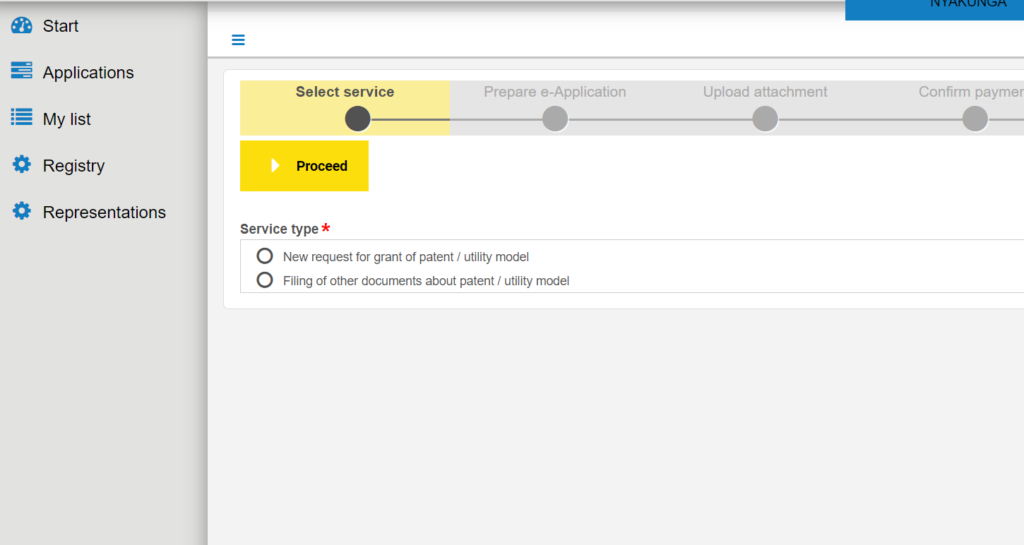
Step 6: Fill in the application form
When filling out the form do not forget to click button [Save] from time to time so you do not lose data entered in case of internet connection disruptions. Note: Browser arrows should not be clicked (data may be lost).
Observe that an application has to be filled in, attachments provided and payment initiated within 6 days from creating the application (please check date “Application created”). After 6 days the application will be automatically deleted and you will need to start registration process all over again.
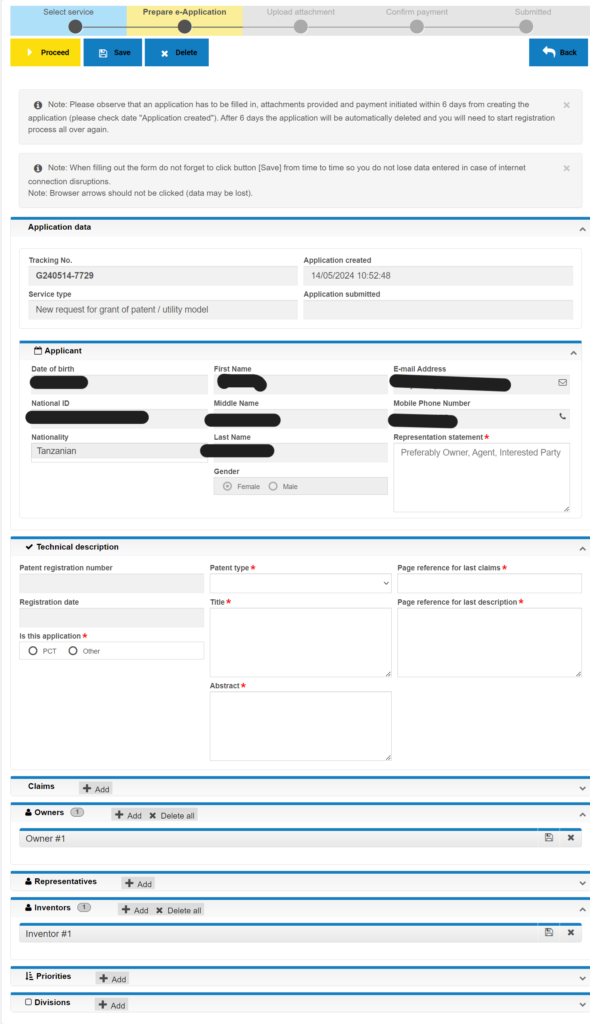
Step 7: Upload Patent Documents
Here you will need to upload the documents you prepared in step 2 and the consolidated form received upon completion of the form filling. All documents must bear respective signatures.
Step 8: Pay Patent Registration Fees
The following table shows the fees related with patent registration in Tanzania. Some of the fees in this table relates with annual maintenance of registered patents.
| SN | ITEM | DETAILS | FEE |
| 1 | Appointment of representative (power of attorney) | Regulation 7 (3) | 0 |
| 2 | On request for grant of a patent | Sections 23 ;regulation 8 | 12000 |
| 3 | On request for grant of a utility certificate | Sections 23and 72 | 10000 |
| 4 | On request for Registrar’s certificate authorizing the release of a sample from a culture collection | Regulation 10(2) | 4000 |
| 5 | On request by Registrar for information concerning corresponding foreign applications, patents or other titles of protection | Regulation 20(1) | 0 |
| 6 | Invitation to correct application for grant of patent or utility certificate | Regulation 25 (1), 52 | 0 |
| 7 | Notification of decision refusing application for grant of patent or utility certificate on grounds of non-compliance with formal requirements | Regulations 25(2).52 | 0 |
| 8 | Notification that application for grant of patent or utility certificate complies with formal requirements | Regulations 25(3),52 | 0 |
| 9 | Notification of non-compliance with substantive requirements and invitation to submit observations and/or amended applications for grant of patent | Regulation 26(3) | 0 |
| 10 | Notification of decision refusing to grant patent on grounds of non-compliance with requirements | Section 26(4) | 0 |
| 11 | Notification of decision to grant patent or utility certificate | Regulations 28(1)(a)52 | 0 |
| 12 | On amendment of application | Section 20, regulation 22 | 8000 |
| 13 | On filling corrections | Section 25(3)(b); regulation 25 | 8000 |
| 14 | For an international-type search | Section 26(2)(a): regulation 26(1) | 10000 |
| 15 | On grant of patent | Section 28 regulation 28(1)(a) | 10000 |
| 16 | On grant of utility certificate | Sections 28 and 72 regulations 27(1)(…and 52(1)) | 8000 |
| 17 | Certificate of grant of patent | Regulation 29(3) | 0 |
| 18 | Certificate of grant of utility certificate | Regulations 29(3),52(1)(c) | 0 |
| 19 | Annual fee for patents | Section 39(1); regulation 30 | |
| 1st anniversary | 4,000 | ||
| 2nd anniversary | 5,000 | ||
| 3rd anniversary | 6,000 | ||
| 4th anniversary | 7,000 | ||
| 5th anniversary | 8,000 | ||
| 6th anniversary | 9,000 | ||
| 7th anniversary | 10,000 | ||
| 8th anniversary | 11,000 | ||
| 9th anniversary | 12,000 | ||
| 10th anniversary | 13,000 | ||
| 11th anniversary | 14,000 | ||
| 12th anniversary | 15,000 | ||
| 13th anniversary | 16,000 | ||
| 14th anniversary | 17,000 | ||
| 20 | Annual fee for utility certificates | Sections 39(1) and 72(1): (regulations 30 and 52)) | |
| 1st anniversary | 3,000 | ||
| 2nd anniversary | 4,000 | ||
| 3rd anniversary | 5,000 | ||
| 4th anniversary | 6,000 | ||
| 5th anniversary | 7,000 | ||
| 6th anniversary | 8,000 | ||
| 21 | Surcharge for extension of the time for payment of annual fee | Section 39 (2);regulation 30 (3)) | |
| Not exceeding one month | 1,000 | ||
| Not exceeding two months | 2,000 | ||
| Not exceeding three months | 3,000 | ||
| Not exceeding four months | 4,000 | ||
| Not exceeding five months | 5,000 | ||
| Not exceeding six months | 6,000 | ||
| 22 | On application for extension of term of a patent | Section 38(2);regulation 31 | 12000 |
| 23 | Application for restoration of a lapsed patent or utility certificate or of an application which is deemed to have been withdrawn | Regulations 32.52 | 0 |
| 24 | On restoration of a lapsed patent or utility certificate or application which is deemed to have been withdrawn | Regulations 32 and 52 | 10000 |
| 25 | Offer to surrender a patent | Sections 62 and 72 regulations 33(1) and 52 | 8000 |
| 26 | Notice of opposition to offer to surrender a patent | regulations 33(2) and 52 | 10000 |
| 27 | Request for alteration of name, nationality, address or address for service | regulation 35 | 4000 |
| 28 | Application to record change in ownership | regulations 36 and 52 | 4000 |
| 29 | Request for inspection of register | regulation 37(2) | 1000 |
| 30 | Request certified copies or extract from the register | regulation 38 | 4000 |
| 31 | Request for the correction of an error in the register or in any connected document | regulation 39(1) | 1500 |
| 32 | Request for the correction of an error relating to patent, patent application , utility certificate or utility certificate application | regulation 39(2) | 1500 |
| 33 | Notice of opposition to the correction of an error relating to a patent or utility certificate | regulation 39(2) | 4000 |
| 34 | Application for recordal of order or court | regulation 40 | 1000 |
| 35 | Petition for registration of licence contract Section 47; regulation 43) | 8000 | |
| 36 | Certificate of receipt of petition for registration of licence contract | regulation 44(1) | 0 |
| 37 | Request for entry in the register to the effect that licences under the patent or utility certificate are available as of right (Section 60(1) and 72 regulation 5091) and 52) | 0 | |
| 38 | Certificate of registration of licence contract | regulation 46 | 0 |
| 39 | Request for conversion of an application for utility certificate into an application for a patent or vice versa | section 74; regulation 52(2) | 5000 |
| 40 | Request for conversion of an application for a patent into an application for a utility certificate | section 74; regulation 52(2) | 3000 |
| 41 | Police of objection to application for entry to be made under regulation 50(1) (Section 60(3) regulation 50(2)) | 10000 | |
| 42 | Application for cancellation of entry to be made under regulation 50(1) (Section 60(7)) | 1500 | |
| 43 | Request for extension of time limit | regulation 55(1) | 0 |
| 44 | Provision of copies of documents under section 5(c) per page | 300 | |
| 45 | Request for bearing | regulation 65 | 10000 |
| 46 | Transmittal fee for international application | regulation 53 | 5000 |
| 47 | Fee for preparation of copies of international application per page 53 | 1500 | |
| 48 | Special fee referred to in Section 32(1)(b) and (2)(b) | 4000 |
3. Formal and Substantive Patent Examination Process
- Formal Examination: BRELA conducts a formal examination to ensure that the application meets the necessary requirements. This includes checking for completeness, proper documentation, and adherence to legal guidelines.
- Publication: Once the application passes the formal examination, it is published in the Tanzania Industrial Property Journal. This publication provides information about the invention, including its title, applicant, and abstract.
- Opposition Period: After publication, there is a specific period during which interested parties can oppose the patent application. They may raise objections based on prior art or other grounds.
- Substantive Examination: If no oppositions are filed or if they are resolved, the application undergoes a substantive examination. BRELA assesses the patentability criteria, such as novelty, inventive step, and industrial applicability.
- Responding to examination reports: the applicant is allowed to respond to examination reports once the report is availed. The report will come as a comment in the BRELA ORS and the applicant will have to make any necessary amendments and respond accordingly.
4. Grant and Maintenance
- Grant or Rejection: Based on the substantive examination, BRELA either grants the patent or rejects the application. If granted, the patentee receives a certificate of grant.
- Patent Registration: The granted patent is officially registered, and the patentee gains exclusive rights to the invention for a specified period.
- Paying maintenance fees: To maintain the validity of the patent, the patentee must pay periodic maintenance fees to the patent office as prescribed by patent laws and regulations. Failure to pay maintenance fees within the specified deadlines may result in the lapse or expiry of the patent, leading to the loss of patent rights.
5. Patent Duration and Renewal
- The term of patent protection is 10 years according to the Patents (Registration) Act, Cap. 217.
- However, it’s essential to note that under the African Regional Intellectual Property Organization (ARIPO), the term of a patent in each member country is 20 years.
- However, this protection can be extended for two additional terms of five years each if the patent owner or licensee can demonstrate that the patent was being actively used in the United Republic or if there were legitimate reasons for non-working.
6. Enforcement and Protection of Patents
Tanzania is a member of the African Regional Intellectual property Organization (ARIPO) and the World Intellectual Property Organization (WIPO) and all protections available under WIPO can be enjoyed by inventor in Tanzania.
On top of that, the Constitution of the United Republic of Tanzania allows ownership of intellectual property and guarantees its protection. To this end, laws have been enacted to promote and protect intellectual property rights. Section 65 of the Act, provides that a person infringes a patent by making, using, offering to sell, selling or importing any patented invention without the owner’s authority during the term of the patent.
A person aggrieved by infringement of patent may institute a suit at the High Court as stipulated by Section 66 of the Act. The Court is mandated to grant the following relief for infringement if infringement is proven as per S. 66 of the Act: (i) An injunction to prevent infringement or to prohibit continuation and (ii) Damages and any other remedies.
 Kessy Juma is the founder of Miamia Trading Company (miamiatz). He is a Techpreneur with roots in accountancy. He believes that any business is good as long as it caters to the right market using the right strategy. |

